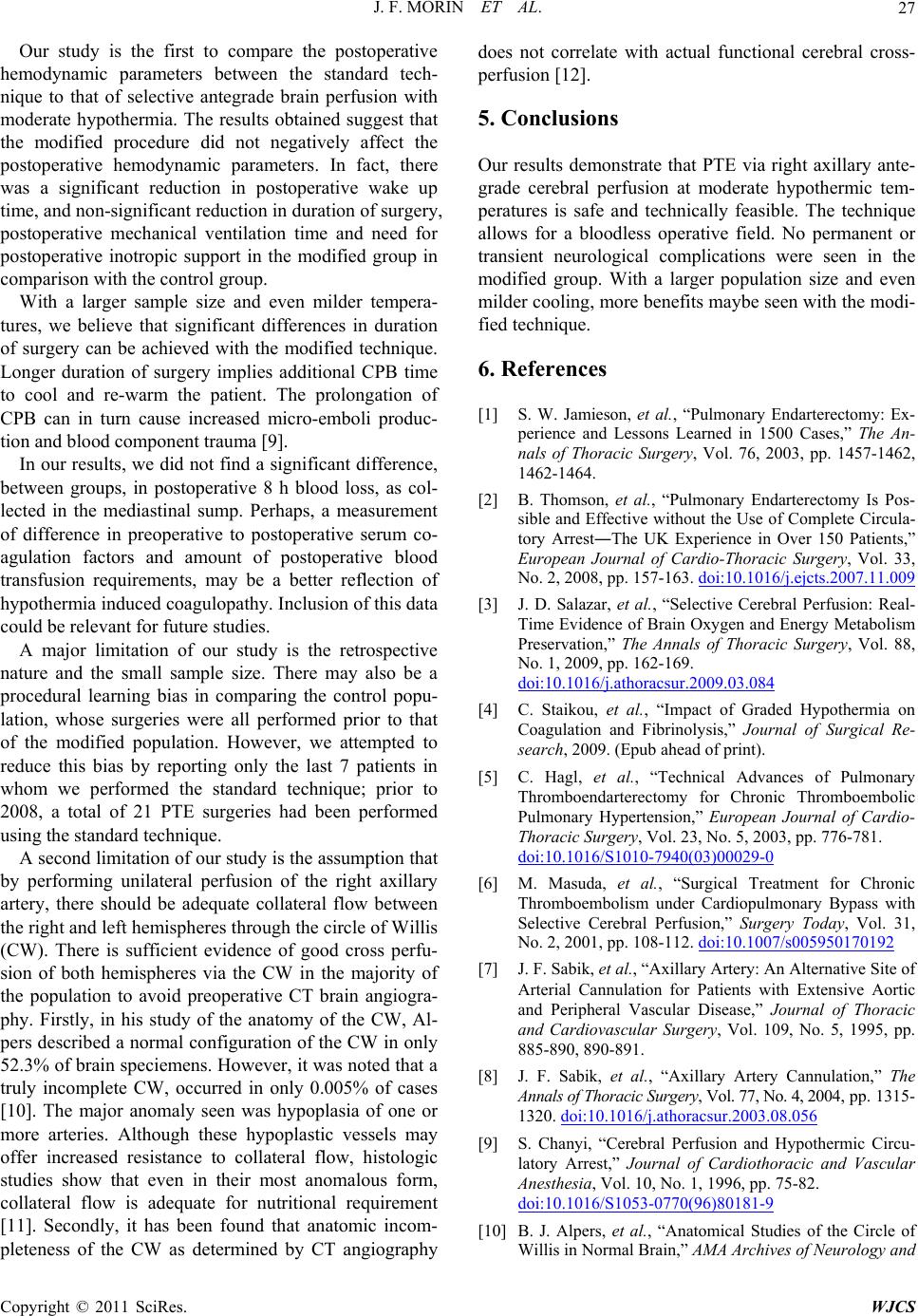
J. F. MORIN ET AL.27
Our study is the first to compare the postoperative
hemodynamic parameters between the standard tech-
nique to that of selective antegrade brain perfusion with
moderate hypothermia. The results obtained suggest that
the modified procedure did not negatively affect the
postoperative hemodynamic parameters. In fact, there
was a significant reduction in postoperative wake up
time, and non-significant reduction in duration of surgery,
postoperative mechanical ventilation time and need for
postoperative inotropic support in the modified group in
comparison with the control group.
With a larger sample size and even milder tempera-
tures, we believe that significant differences in duration
of surgery can be achieved with the modified technique.
Longer duration of surgery implies additional CPB time
to cool and re-warm the patient. The prolongation of
CPB can in turn cause increased micro-emboli produc-
tion and blood component trauma [9].
In our results, we did not find a significant difference,
between groups, in postoperative 8 h blood loss, as col-
lected in the mediastinal sump. Perhaps, a measurement
of difference in preoperative to postoperative serum co-
agulation factors and amount of postoperative blood
transfusion requirements, may be a better reflection of
hypothermia induced coagulopathy. Inclusion of this data
could be relevant for future studies.
A major limitation of our study is the retrospective
nature and the small sample size. There may also be a
procedural learning bias in comparing the control popu-
lation, whose surgeries were all performed prior to that
of the modified population. However, we attempted to
reduce this bias by reporting only the last 7 patients in
whom we performed the standard technique; prior to
2008, a total of 21 PTE surgeries had been performed
using the standard technique.
A second limitation of our study is the assumption that
by performing unilateral perfusion of the right axillary
artery, there should be adequate collateral flow between
the right and left hemispheres through the circle of Willis
(CW). There is sufficient evidence of good cross perfu-
sion of both hemispheres via the CW in the majority of
the population to avoid preoperative CT brain angiogra-
phy. Firstly, in his study of the anatomy of the CW, Al-
pers described a normal configuration of the CW in only
52.3% of brain speciemens. However, it was noted that a
truly incomplete CW, occurred in only 0.005% of cases
[10]. The major anomaly seen was hypoplasia of one or
more arteries. Although these hypoplastic vessels may
offer increased resistance to collateral flow, histologic
studies show that even in their most anomalous form,
collateral flow is adequate for nutritional requirement
[11]. Secondly, it has been found that anatomic incom-
pleteness of the CW as determined by CT angiography
does not correlate with actual functional cerebral cross-
perfusion [12].
5. Conclusions
Our results demonstrate that PTE via right axillary ante-
grade cerebral perfusion at moderate hypothermic tem-
peratures is safe and technically feasible. The technique
allows for a bloodless operative field. No permanent or
transient neurological complications were seen in the
modified group. With a larger population size and even
milder cooling, more benefits maybe seen with the modi-
fied technique.
6. References
[1] S. W. Jamieson, et al., “Pulmonary Endarterectomy: Ex-
perience and Lessons Learned in 1500 Cases,” The An-
nals of Thoracic Surgery, Vol. 76, 2003, pp. 1457-1462,
1462-1464.
[2] B. Thomson, et al., “Pulmonary Endarterectomy Is Pos-
sible and Effective without the Use of Complete Circula-
tory Arrest―The UK Experience in Over 150 Patients,”
European Journal of Cardio-Thoracic Surgery, Vol. 33,
No. 2, 2008, pp. 157-163. doi:10.1016/j.ejcts.2007.11.009
[3] J. D. Salazar, et al., “Selective Cerebral Perfusion: Real-
Time Evidence of Brain Oxygen and Energy Metabolism
Preservation,” The Annals of Thoracic Surgery, Vol. 88,
No. 1, 2009, pp. 162-169.
doi:10.1016/j.athoracsur.2009.03.084
[4] C. Staikou, et al., “Impact of Graded Hypothermia on
Coagulation and Fibrinolysis,” Journal of Surgical Re-
search, 2009. (Epub ahead of print).
[5] C. Hagl, et al., “Technical Advances of Pulmonary
Thromboendarterectomy for Chronic Thromboembolic
Pulmonary Hypertension,” European Journal of Cardio-
Thoracic Surgery, Vol. 23, No. 5, 2003, pp. 776-781.
doi:10.1016/S1010-7940(03)00029-0
[6] M. Masuda, et al., “Surgical Treatment for Chronic
Thromboembolism under Cardiopulmonary Bypass with
Selective Cerebral Perfusion,” Surgery Today, Vol. 31,
No. 2, 2001, pp. 108-112. doi:10.1007/s005950170192
[7] J. F. Sabik, et al., “Axillary Artery: An Alternative Site of
Arterial Cannulation for Patients with Extensive Aortic
and Peripheral Vascular Disease,” Journal of Thoracic
and Cardiovascular Surgery, Vol. 109, No. 5, 1995, pp.
885-890, 890-891.
[8] J. F. Sabik, et al., “Axillary Artery Cannulation,” The
Annals of Thoracic Surgery, Vol. 77, No. 4, 2004, pp. 1315-
1320. doi:10.1016/j.athoracsur.2003.08.056
[9] S. Chanyi, “Cerebral Perfusion and Hypothermic Circu-
latory Arrest,” Journal of Cardiothoracic and Vascular
Anesthesia, Vol. 10, No. 1, 1996, pp. 75-82.
doi:10.1016/S1053-0770(96)80181-9
[10] B. J. Alpers, et al., “Anatomical Studies of the Circle of
Willis in Normal Brain,” AMA Archives of Neurology and
Copyright © 2011 SciRes. WJCS